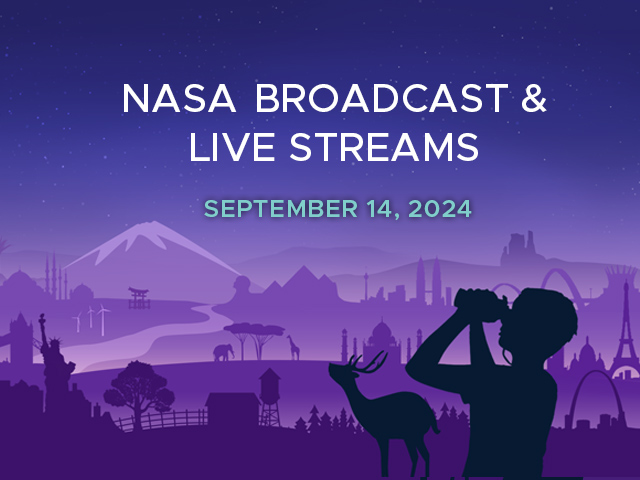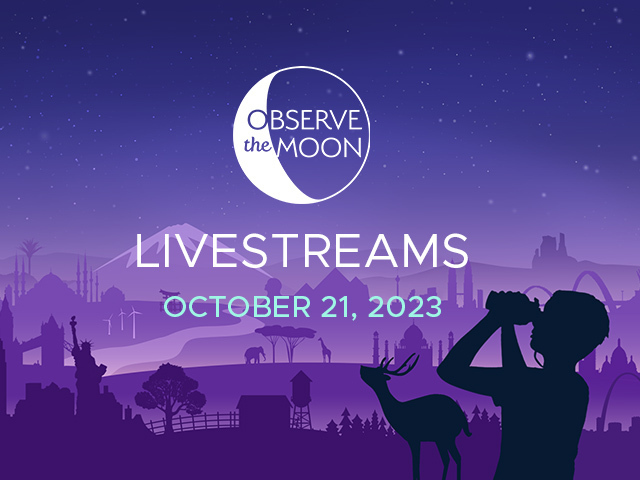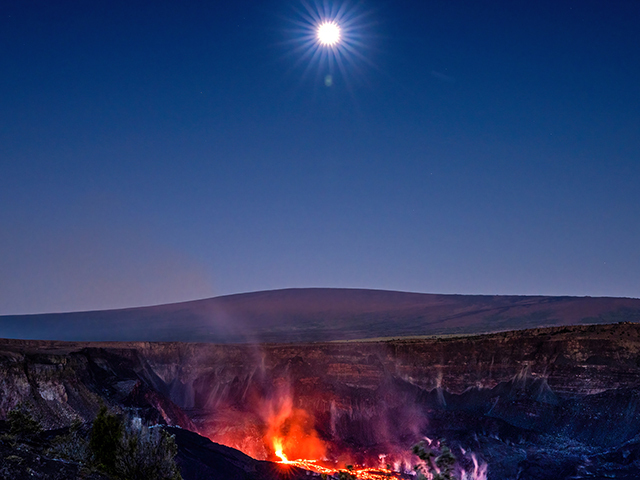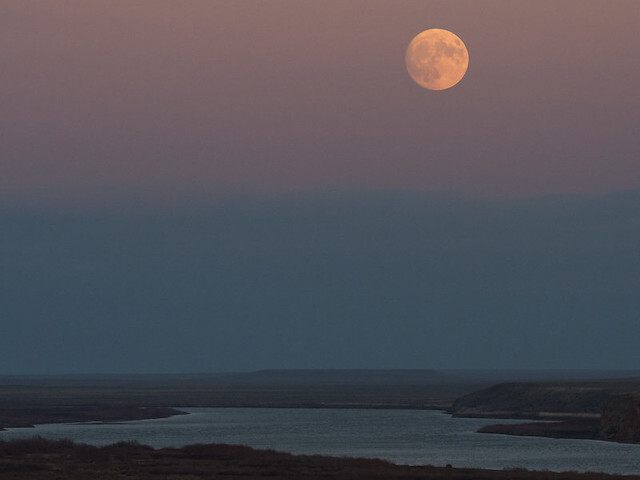News | October 12, 2016
The Hunter's Moon
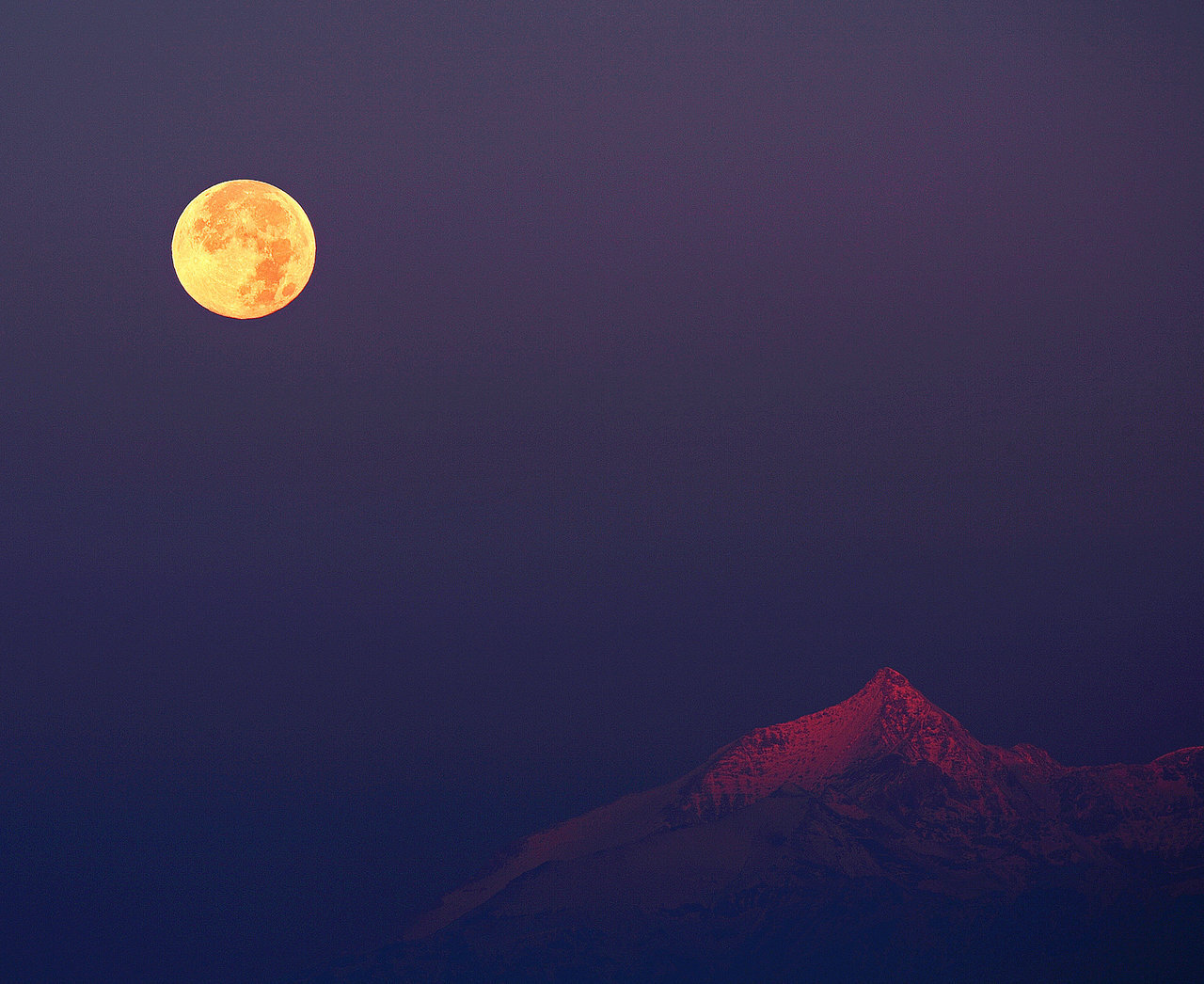
The next full Moon will be just after midnight on Sunday morning, October 16, 2016, appearing "opposite" the Sun (in Earth-based longitude) at 12:23 AM EDT, right in the middle of the weekend. The Moon will appear full for about three days around this time, from Friday evening through Monday morning, making this a full Moon weekend.
This is the Hunter's Moon, the full Moon after the Harvest Moon. According to the Farmer's Almanac, with the leaves falling and the deer fattened, it is time to hunt. Since the harvesters have reaped the fields, hunters can easily see the animals that have come out to glean (and the foxes that have come out to prey on them). The earliest use of the term "Hunter's Moon" cited in the Oxford English Dictionary is from 1710.
As the early Fall Moon or first full Moon after the Autumnal Equinox, this full Moon is also called the Travel Moon, Dying Grass Moon, and the Sanguine or Blood Moon. This full Moon is also Sharad Purnima or Kojaagari Purnima, a harvest festival celebrated on the full Moon day of the Hindu lunar month of Ashvin. The rainy season is over and the brightness of the full Moon brings special joy. This is a traditional celebration of the Moon and is also called the Kaumudi celebration, Kaumudi meaning moonlight.
In lunisolar calendars the months change with the new Moon and full Moons fall in the middle of the lunar month. This full Moon is the middle of the ninth month of the Chinese calendar and Tishri in the Hebrew calendar. The high holidays of Rosh Hashanah and Yom Kippur occur during the first weeks of Tishri, and his full Moon corresponds with the start of the Sukkoth holiday.
In the Islamic calendar the months start with the first sighting of the waxing crescent Moon a few days after the New Moon. This full Moon is near the middle of Muharram, the first month of the calendar, one of the four sacred months of the year.
As usual, the wearing of suitably celebratory celestial attire is encouraged in honor of the full Moon.
As for other celestial sights between now and the full Moon after next:
In early autumn the daily periods of sunlight continue to shorten. For the Washington, DC area, on the day of the October full Moon, morning twilight will begin at 6:21 AM, sunrise will be at 7:19 AM, the Sun will reach a maximum altitude of 41.9 degrees at 12:53 PM, sunset will be at 6:27 PM, and evening twilight will end at 7:25 PM EDT. By the day of the November full Moon, we will have switched from Daylight Savings to Standard Time, morning twilight will begin at 5:50 AM, sunrise will be at 6:50 AM, the Sun will reach a maximum altitude of 32.7 degrees at 11:52 AM, sunset will be at 4:55 PM, and evening twilight will end at 5:55 PM EST.
On the evening of the October full Moon, as evening twilight ends, the planet Venus appears low in the west-southwest. Low in the southwest the bright planet Saturn will appear above the bright star Antares. The planet Mars will appear higher and more to the south-southwest. Our home galaxy, the Milky Way, will be spread across the sky from the south-southwest to the north-northeast, but with all the artificial lighting now in use, 80 percent of us in the USA can no longer see it (according to a global night sky atlas from the Light Pollution Science and Technology Institute). Although the center of the milky way is in the sky, we are looking away from the local arm of our galaxy, so relatively fewer bright stars are visible than in the morning sky. The most prominent visible stars appear almost directly overhead, Altair, Deneb, and Vega, the brightest stars in the three constellations of Aquila, Cygnus, and Lyra, respectively. We call this trio of stars the Summer Triangle. Altair (17 light years from Earth) appears to the south, Deneb (800 light years from Earth) to the north-northeast, and the brightest of the three, Vega (25 light years from Earth) to the northwest. As October progresses the stars will appear to shift each night towards the west. Venus as the evening star will appear to skirt along the horizon towards the south until Saturn, Venus, and Antares appear to line up the evening of October 27, 2016.
On the morning of the October full Moon, as morning twilight begins, the planet Jupiter will appear low in the east, having passed around the far side of the Sun as seen from Earth (and moved from the evening to the morning sky) on September 26. Our home galaxy, the Milky Way, will be spread across the sky, from the south-southeast to the the north-northeast (although we can only see it from a very dark location far from city lights). Although we will be looking away from the center of the galaxy, we will be looking towards the local galactic arm, so we can see many more bright stars, including the brightest of the stars, Sirius. The planet Mercury will also be visible in the glow of dawn, rising below Jupiter about 45 minutes before sunrise, but over the course of the next few mornings Mercury will appear to shift nearer to the rising Sun and become harder to see each morning. As the month progresses, Mercury will vanish from view, while Jupiter will appear higher each morning. The bright stars of the local arm of the Milky Way will appear to shift further toward the west each evening.
The annual Orionid meteor shower, caused from debris from Halley's comet hitting the Earth's atmosphere, will be active from October 4 to November 14, 2016, peaking early in the morning of October 21, 2016. This year, the light from the waning gibbous Moon will interfere with observing meteors at the peak of this shower.
Even though they are not visible usually, I include in these Moon missives information about Near Earth Objects (mostly asteroids) that pass the Earth within about 15 lunar distances, because I find it interesting that we have discovered so many. On Thursday evening, October 13, 2016 at 7:44 PM EDT (2016-Oct-13 23:44 UTC), Near Earth Object (2016 TX17), between 53 and 119 meters (174 to 389 feet) in diameter, will pass the Earth at between 15.9 and 16.3 lunar distances (nominally 16.1), traveling at 17.41 kilometers per second (38,941 miles per hour).
Although not visible without a telescope, Saturday, October 15, 2016, at 6:15 AM EDT, is when the planet Uranus will be at Opposition, or opposite the Sun in Earth-based longitude, and at its brightest and closest to the Earth for the year.
On Saturday night, October 15, 2016 at 10:20 PM EDT (2016-Oct-16 02:20 UTC), Near Earth Object (1993 TZ), between 17 and 38 meters (55 to 123 feet) in diameter, will pass the Earth at 14.4 lunar distances, traveling at 12.71 kilometers per second (28,438 miles per hour).
As mentioned above, the next full Moon will be just after midnight on Sunday, October 16, 2016, at 12:23 AM EDT. The full Moons in October, November, and December will be what some people call "SuperMoons," although the November full Moon will be closer and brighter than the October or December full Moons.
On Sunday evening, October 16, 2016 at 6:23 PM EDT (2016-Oct-16 22:23 UTC with), Near Earth Object (2016 TH10), between 31 and 68 meters (100 to 224 feet) in diameter, will pass the Earth at between 7.2 and 7.4 lunar distances (nominally 7.3), traveling at 12.39 kilometers per second (27,710 miles per hour).
Sunday evening, October 16, 2016, at 7:36 PM EDT, the Moon will be at perigee, its closest to the Earth for this orbit. At 357,900 km from Earth, the Moon will be almost 14% closer than it will be when it is at apogee at the end of October.
On Monday night, October 17, 2016 at 11:49 PM EDT (2016-Oct-18 03:49 UTC with), Near Earth Object (2014 UR), between 13 and 28 meters (42 to 93 feet) in diameter, will pass the Earth at 12.0 lunar distances, traveling at 4.31 kilometers per second (9,636 miles per hour).
On Tuesday evening, October 18, 2016 at 6:31 PM EDT (2016-Oct-18 22:31 UTC), Near Earth Object (2016 TE55), between 18 and 39 meters (58 to 129 feet) in diameter, will pass the Earth at between 13.0 and 13.3 lunar distances (nominally 13.2), traveling at 12.99 kilometers per second (29,069 miles per hour).
On Tuesday evening, October 18, 2016, into Wednesday morning, October 19, 2016, the bright star Aldebaran will appear near the waning gibbous Moon. Aldebaran will appear so near that the Moon will pass in front of Aldebaran and block it from view. For the Washington, DC area (exact times will vary depending upon your location), the Moon will rise at 8:44 PM EDT and Aldebaran will rise below and to the left of the Moon about 10 minutes later. Aldebaran will disappear behind the bright limb of the Moon on Wednesday morning at 1:37 AM. My experience is that even with binoculars, the bright Moon will make it hard to see Aldebaran disappear. You should be able to see Aldebaran suddenly reappear from behind the dark, upper right limb of the Moon at about 2:43 AM. The Moon and Aldebaran will be at their highest in the sky for the morning at 3:55 AM. Morning twilight will begin at 6:24 AM.
Friday morning, October 21, 2016, just after midnight, is the predicted peak of the annual Orionid Meteor Shower. This year, the light of the waning gibbous Moon will make it difficult to see these meteors. The Orionids are specs of dust from Halley's Comet that enter the Earth's atmosphere at about 67 kilometers per second (150,000 miles per hour).
On Saturday morning, October 22, 2016, the half-full Moon will appear to line up between the bright stars Procyon and Pollux. As they rise in the east-northeast, Pollux will appear to the upper left and Procyon to the lower right of the Moon.
Saturday afternoon, October 22, 2016, the waning Moon will appear half-full as it reaches its last quarter at 3:14 PM EDT.
On Tuesday morning, October 25, 2016, the bright star Regulus will appear above the waning crescent Moon. For the Washington, DC area, Regulus will rise at 2:18 AM EDT and the Moon will rise 15 minutes later. Morning twilight will begin around 6:30 AM.
On Tuesday evening, October 25, 2016, and again on Wednesday evening, October 26, 2016, the bright planet Venus will appear low in the southwest above the bright star Antares, with Saturn appearing higher above the pair. Venus and Antares will pass at their closest on Wednesday morning when we are not able to see them from the Washington, DC area.
Thursday, October 27, 2016, at 11:53 AM EDT, is when the planet Mercury passes around the far side of the Sun as seen from Earth, called Superior Conjunction.
On Thursday mid-day, October 27, 2016 at 12:47 PM EDT (2016-Oct-27 16:47 UTC), Near Earth Object 413260 (2003 TL4), between 350 and 784 meters (1/5 to 1/2 mile) in diameter, will pass the Earth at 10.1 lunar distances, traveling at 10.35 kilometers per second (23,145 miles per hour).
Thursday evening, October 27, 2016, the bright planet Venus as the evening star will appear in the southwest in a vertical line between the planet Saturn and the bright star Antares. For the Washington, DC area, when evening twilight ends at 7:12 PM EDT, Saturn will appear 11 degrees above the horizon, Venus 7 degrees above the horizon, and Antares 4 degrees above the horizon. Antares will set around 7:41 PM, Venus at 8:01 PM, and Saturn at 8:23 PM EDT.
On Friday morning, October 28, 2016, if you have a clear view of the eastern horizon, you might catch a glimpse of the planet Jupiter to the right of the thin, waning crescent Moon. For the Washington, DC area, the Moon and Jupiter will rise together around 5:26 AM EDT. Morning twilight will begin around 6:33 AM.
On Saturday morning, October 29, 2016 at around 1:51 AM EDT (2016-Oct-29 05:51 UTC with 30 minutes uncertainty), Near Earth Object (2016 TZ19), between 58 and 130 meters (191 to 427 feet) in diameter, will pass the Earth at between 18.2 and 19.7 lunar distances (nominally 18.9), traveling at 16.46 kilometers per second (36,819 miles per hour).
On Saturday evening, October 29, 2016, the planet Venus as the evening star will appear at its closest to the planet Saturn, just 3 degrees apart and about 10 degrees above the horizon in the southwest, with the bright star Antares appearing below (about 3 degrees above the horizon).
Sunday, October 30, 2016, at 12:38 PM EDT, will be the new Moon, when the Moon passes between the Earth and the Sun and will not be visible from the Earth.
On Halloween morning, Monday, October 31, 2016 at 5:25 AM EDT (2016-Oct-31 09:25 UTC), Near Earth Object 164121 (2003 YT1), between 1,530 and 3,420 meters (about 1 to 2 miles) in diameter, will pass the Earth at 13.5 lunar distances, traveling at 24.06 kilometers per second (53,818 miles per hour).
On Halloween, Monday, October 31, 2016, at 2:29 PM EDT, the Moon will be at apogee, 406,700 km from Earth, its farthest for this orbit.
On Wednesday evening, November 2, 2016, the waxing crescent Moon will join the cluster of Saturn, Antares, and Venus, low on the southwestern horizon. If you have a clear view of the horizon, you should be able to see the Moon on top, Saturn below the Moon, Antares below Saturn close to the horizon, and Venus off to the left. Mars will be visible as well, higher in the sky and more to the south.
On Thursday evening, November 3, 2016, sometime around 9:38 PM EDT (2016-Nov-04 01:38 UTC with 1 hour and 21 minutes uncertainty), Near Earth Object (2016 TG55), between 19 and 43 meters (63 to 141 feet) in diameter, will pass the Earth at between 3.8 and 3.9 lunar distances (nominally 3.9), traveling at 5.98 kilometers per second (13,388 miles per hour).
Late Friday night into early Saturday morning, November 5, 2016, is the predicted peak of the South Taurid meteor shower. This shower is a broad shower lasting from about September 25 to November 25. Because this shower is so broad, it does not have a strong peak. Under good viewing conditions far from city lights the peak is expected to be only about 7 meteors per hour. Although few in numbers, the Taurids tend to have a larger percentage of bright fireballs compared to most meteor showers.
Saturday, November 5, 2016, for those parts of the U.S. that use Daylight Savings Time, will be the latest sunrise (darkest morning) of the year. For the Washington, DC area, sunrise will be at 7:40 AM EDT, a 13 minutes later than the latests sunrises after the winter solstice. The 12 days from October 25 to November 5 will be the darkest mornings of 2016.
For the Washington, DC area at least, the sunrise at 7:40 am EDT on Saturday, November 5, 2016, will be the latest sunrise of the year, 18 minutes later that the sunrise at 7:22 am EDT on March 13, 2016 (the start of Daylight Savings Time) and 13 minutes later than the winter sunrises at 7:27 am EST in late December and early January. The 12 days from October 25 to November 5, 2016 will be the darkest mornings with sunrises later than at any other time of the year. If it seems particularly difficult to get up in the mornings the last week in October and the beginning of November, this may be why (and if it is not why, this is still a good excuse to sleep in).
In the evening of Saturday, November 5, and again in the evening of Sunday, November 6, 2016, the planet Mars will appear near the waxing crescent Moon. On Saturday Mars will be to the lower left of the Moon, and by Sunday the Moon will have shifted so that Mars is to the lower right of the Moon.
On Sunday, November 6, 2016, don't forget to set your clocks back an hour as we "Fall Back" with the end of Daylight Savings Time.
On Monday morning, November 7, 2016 at 1:01 AM EST (2016-Nov-07 06:01 UTC), Near Earth Object (2002 UQ12), between 97 and 216 meters (317 to 708 feet) in diameter, will pass the Earth at 19.4 lunar distances, traveling at 20.08 kilometers per second (44,923 miles per hour).
On Monday, November 7, 2016, the Moon will appear half-full as it reaches its first quarter at 2:51 PM EST.
Sometime around Thursday morning, November 10, 2016 (2016-Nov-10 13:33 UTC with 1 day, 5 hours, and 6 minutes uncertainty), Near Earth Object (2004 KB), between 160 and 358 meters (525 to 1,175 feet or about 1/10 to 1/4 mile) in diameter, will pass the Earth at between 8.7 and 28.4 lunar distances (nominally 10.0), traveling at 13.52 kilometers per second (30,247 miles per hour).
Late Friday night into early Saturday morning, November 12, 2016, is the predicted peak of the North Taurid meteor shower. This shower is a broad shower lasting from about October 12 to December 2. Just like the South Taurids, because this shower is so broad, it does not have a strong peak. Unlike the earlier South Taurids, the light of the waxing gibbous Moon will make it hard to see the fainter meteors, the Taurids tend to have a larger percentage of bright fireballs compared to most meteor showers, and although rare, these would be visible.
Monday, November 14, 2016, at 6:23 AM EST, the Moon will be at perigee, its closest to the Earth for this orbit. At 356,500 km from Earth, the Moon will be 14% closer than when it was at apogee at the end of October.
The full Moon after next will be on Monday, November 14, 2016, at 8:52 AM EST. Since this full Moon occurs just 2.5 hours after perigee, this will be what has come to be called a "SuperMoon."


